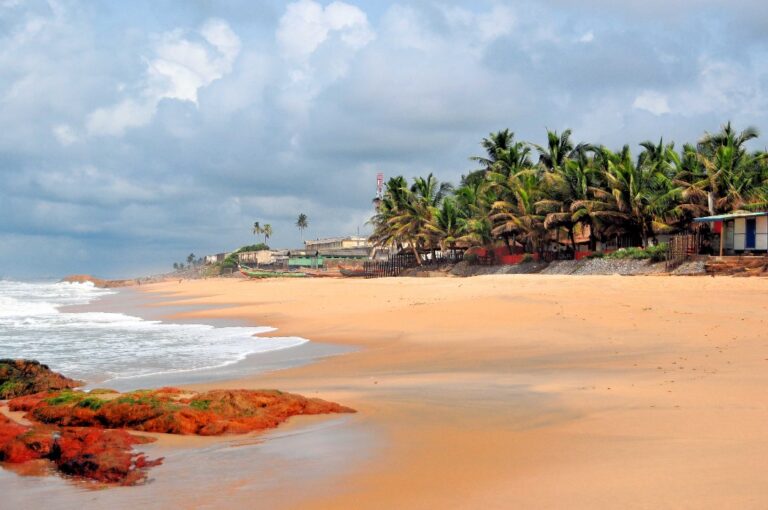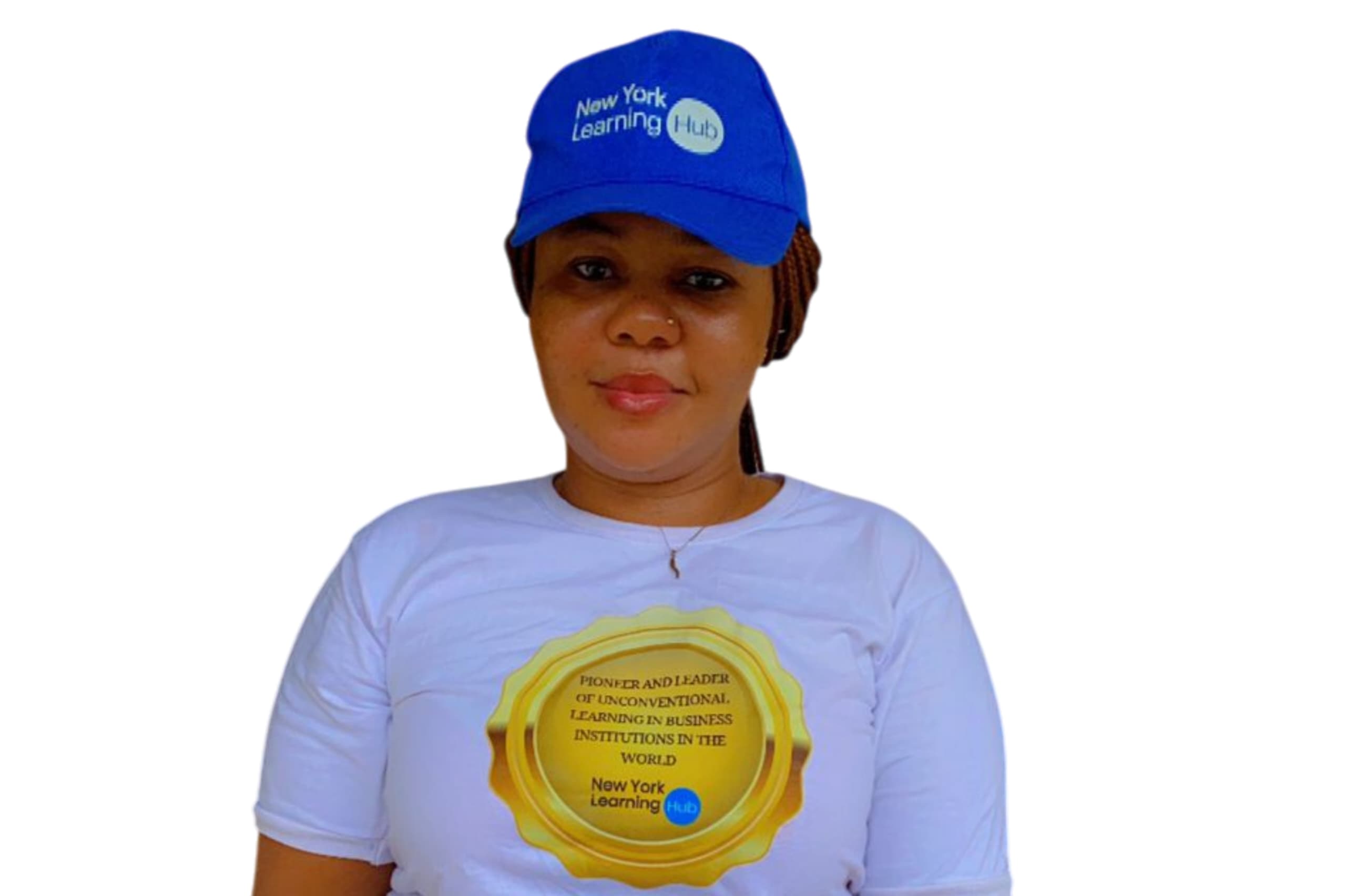At the New York Learning Hub, one of the most influential forums for research and policy discussion, Prof. MarkAnthony Ujunwa Nze, a distinguished journalist and editor-in-chief of People & Polity Incorporated in New York, delivered an urgent and compelling presentation on the escalating crisis of coastal erosion in Ghana’s fishing communities. A strategic management and leadership expert with a proven track record in addressing complex global challenges, Prof. MarkAnthony Nze presented findings from his latest study, which investigates the human cost of coastal erosion in Ghana—a phenomenon he described as not just an environmental issue, but a profound socio-economic and cultural crisis.
In his presentation, titled “Eroding Livelihoods: The Human Cost of Coastal Erosion in Ghana’s Fishing Communities”, Prof. MarkAnthony Nze illuminated the devastating impacts of this silent catastrophe. Drawing from extensive research conducted across four coastal fishing communities in Ghana, the study reveals how climate-driven coastal erosion is reshaping lives, disrupting traditional economies, and threatening the very identity of these culturally rich and economically vital communities.
Ghana’s 540-kilometer coastline, home to more than 25 percent of the nation’s population, has long been the lifeblood of artisanal fishing. This sector employs over 2.2 million people and provides 60 percent of the country’s protein needs. Yet, as Prof. MarkAnthony’s research shows, the encroaching sea is swallowing entire villages, displacing families, and eroding the natural and cultural foundations that have sustained these communities for generations. “When the coastline disappears, it takes more than just land with it,” Prof. MarkAnthony Nze explained. “It destroys livelihoods, dismantles communities, and erases history.”
The study, which employed a mixed-methods approach, integrates quantitative data from surveys of 200 participants and qualitative interviews with 15 stakeholders, including fishermen, fish processors, community leaders, and environmental experts. Multivariate regression analysis revealed that key factors such as proximity to the coastline, storm frequency, and displacement history significantly affect household economic stability. Communities closer to the coastline, particularly those displaced by erosion, reported severe income losses, declining fishing yields, and higher levels of financial insecurity.
Prof. Nze also highlighted the environmental drivers behind coastal erosion, identifying sand mining, mangrove deforestation, and intensified storm surges as the primary culprits. His research found that sand mining, often driven by high demand for construction materials, is the most destructive human activity accelerating shoreline retreat. “Each ton of sand extracted destabilizes the coastline and pushes vulnerable communities closer to disaster,” he said.
The cultural cost of erosion is equally profound. Through personal interviews, fishermen described the emotional toll of losing traditional fishing grounds, while families expressed grief over the destruction of ancestral homes, sacred sites, and community cohesion. Women, who play a central role in fish processing and trade, shared how reduced fish stocks have disrupted their livelihoods, deepening the economic and social vulnerabilities of their households.
As part of his recommendations, Prof. Nze called for urgent policy action. He stressed the need for stricter enforcement of environmental regulations, large-scale mangrove replanting initiatives, and the development of sustainable livelihood programs for displaced families. He also emphasized the importance of community-based adaptation strategies and the adoption of integrated coastal zone management (ICZM) policies to address both environmental and socio-economic dimensions of the crisis.
“This is not just Ghana’s problem,” Prof. Nze concluded. “It is a global challenge that requires collaborative action, not only to protect vulnerable communities but also to preserve the ecosystems that sustain life along our coasts. The world must wake up to the human and cultural costs of erosion before it’s too late.”
The study stands as a powerful call to action, urging governments, development organizations, and international stakeholders to prioritize the resilience and well-being of coastal communities. Prof. Nze’s presentation at the New York Learning Hub marks a significant step toward raising global awareness of Ghana’s coastal crisis and driving collective solutions to one of the most pressing challenges of our time.
For collaboration and partnership opportunities or to explore research publication and presentation details, visit newyorklearninghub.com or contact them via WhatsApp at +1 (929) 342-8540. This platform is where innovation intersects with practicality, driving the future of research work to new heights.
Full publication is below with the author’s consent.
Abstract
Eroding Livelihoods: The Human Cost of Coastal Erosion in Ghana’s Fishing Communities
Coastal erosion in coastal communities in Ghana is a critical socio-environmental issue, impacting livelihoods, cultural heritage, and ecosystems. In an attempt to understand its social dimensions, this research examined social, economic, and cultural dimensions of coastal erosion through a mixed-methods study design. Information collected through 200 survey respondents, 15 in-depth interviews, and four case studies in coastal communities in Ghana yields a rich analysis of its impact on household life, social structures, and environment concerns.
The multivariate analysis showed that factors such as household earnings, yield in terms of fish, storm events’ frequency, cases of displacement, and distance to shoreline act as significant factors in economic vulnerability. The study reveals that displaced households suffer significant drops in earnings, with repeat storm events compounding financial hardships for communities whose livelihoods depend on fishing for a living. Environmental studies have pinpointed sand mining, cutting down of mangroves, and storm surges as key factors in coastal erosion, with sand mining contributing a particularly damaging impact towards shoreline stability.
The rich depiction derived through inductive analysis supplemented quantitative information with an in-depth analysis of coastal erosion impact towards traditional life, family dislocations, and degradation of heritage values. Fishermen have experienced a drop in stocks and reduced yields, and women working in processing have experienced increased financial hardships through reduced access to raw fish for processing work. Community respondents have mourned loss of traditional housing, sacred locations, and social cohesion, underlining critical social and cultural consequences of dislocations.
The study describes the interconnected consequences of social, economic, and environment factors that arise following coastal erosion, and promotes interventions taking a multi-dimensional view. Suggested interventions include strengthening compliance with environmental laws in a move to curb sand mining and mangrove cutting, strengthening community-led interventions such as mangrove re-afforestation, and offering alternative livelihood for family members impacted by coastal erosion. In addition, the study promotes development and integration of Integrated Coastal Zone Management (ICZM) planning approaches in a manner that reconciles restoration of the ecosystem with social and economic development.
The analysis identifies an imperative for state and development agencies, and community groups to tackle root causes of coastal erosion, even as a high level of concern for coastal communities’ welfare is prioritized. By situating analysis in a community lens and raising community voice, the study proposes interventions with a view towards developing resilient approaches. Coastal erosion in coastal areas in Ghana is not a simple environment issue but a critical humanitarian challenge whose resolution necessitates coordinated, participatory, and long-term interventions towards protecting and enhancing both coastal communities and coastal environments.
Chapter 1: Introduction
1.1 Background
Coastal erosion is a critical environmental and socio-economic issue for countries worldwide, and in countries with high population densities and economies that depend on coastal assets, it is a critical issue of concern. In Ghana, coastal erosion is not just an issue of simple degradation of the environment; it is a threat to coastal communities’ livelihoods, cultural heritage, and security, having lived for centuries off marine assets for survival. The 540-kilometer long coast of Ghana borders the Gulf of Guinea, and over 25 percent of its population lives in coastal communities. Most of these coastal communities have a high proportion of artisanal fishermen, whose welfare and cultural heritage depend intimately on a healthy marine environment and conservation of coastal habitats.
Artisanal fisheries form an important part of Ghana’s economy, employing over 2.2 million and contributing a significant proportion to national food security, with over 60 percent of national protein consumption derived from consumption of fish and aquatic foods. In addition, it helps maintain cultural heritage, with traditional techniques having been handed down through successive generations. Climate change, fueled by coastal erosion, poses a dire challenge to such an age-old practice, with increased sea level rise, increased storm surges, and degradation of coastal protective structures, such as mangroves and coastal dunes, causing loss of critical lands and dislodging family groups, including traditional fishermen, off homesteads and traditional hunting and fishing grounds. In addition, habitat loss for fish and a loss in stocks have made many a family unable to maintain livelihoods.
Human activities worsen the problem. Coastal mining, unregulated coastal development, and overexploitation of natural resources have increased coastal erosion, accelerated loss of land, and destabilized coastal communities even further. Despite the severity of the problem, the overall human cost involved in coastal erosion in Ghana has not yet received careful analysis in academic and policy discourses. Despite a significant part of current studies focusing on its environment-related dimensions, a considerable lack of understanding in its socio-economic and cultural consequences prevails. Overcoming such a lack is critical in developing interventions not only to mitigate environment degradation but also to benefit communities most impacted negatively by such a problem.
The current study looks at coastal erosion and its impact in transforming lives in coastal communities in Ghana. In focusing on its economic, social, and cultural consequences, it seeks to contribute to an increased awareness of the problems faced by such groups and strategies for survival and adaptability. Quantitative approaches, such as analysis of regressions of economic and environmental statistics, and qualitative information generated through interviews and case studies, combine in providing a full picture of the issue in question.
1.2 Problem Statement
Coastal erosion in Ghana is not only an environmental issue but a socio-economic disaster with widespread implications. The accelerated loss of land jeopardizes not only the settlements and sources of livelihood for many coastal communities—many living at, and sometimes below, the poverty level—but whole communities, whose survival and livelihoods are threatened when such communities have to move inland, displaced from their traditional lands to new, and in many cases, crowded, areas. Losses in habitats, including breeding and nursery habitats, and supporting environments for artisanal fisheries, have translated into reduced yields, and in a knock-on impact, have reduced incomes at the household level.
Apart from its economic impact, coastal erosion is a danger to coastal communities’ cultural integrity. Coastal erosion often destroys such culturally important locations, such as graveyards and sacred areas, with high cultural and spiritual value. As communities move, traditional customs, traditional knowledge, and social structures break down. Environmental degradation and social disarray caused by coastal erosion threaten not only current welfare but coastal communities’ long-term viability, too.
The lack of effective policies and correct information about coastal erosion and its impact on coastal communities worsens the case. Despite such programs such as seawall construction and coastal re-afforestation of coastal mangroves, such interventions have in many cases been poorly coordinated and underfunded in individual areas. There is a critical imperative to merge environment and humans studies in a proper analysis and effective intervention for a whole range of coastal erosion-related challenges.
This research seeks to respond to the critical necessity for an analysis of social and economic consequences of coastal erosion in coastal communities in Ghana. Documenting and collecting first-hand information through communities most impacted, the study seeks to generate insights to inform interventions designed to build social resilience and preserve environment integrity.
1.3 Research objectives
The overall purpose of this study is to assess the human consequences of coastal erosion in coastal communities in Ghana, with an examination of economic loss, cultural disruption, and adaptability. In keeping with its aims, the study aims to calculate coastal erosion impacts in relation to household earnings, fisheries yields, and housing security, and explore cultural consequences such as community dislocation and loss of traditional livelihoods. In addition, the study aims to both enumerate and explore factors driving coastal erosion, including both environment and human-related factors, and evaluate effectiveness of adaptations in current practice.
Utilizing a mixed-methods investigation combining both quantitative and qualitative approaches, this study presents an in-depth analysis of coastal erosion’s impact on lives of communities located in coastal areas in Ghana, providing actionable information for development agencies, community leaders, and government agencies.
1.4 Scope and Significance
The present investigation covers four coastal communities in Ghana, representing a diversity of impacts stemming from coastal erosion. Target communities have been selected in consideration of geographical diversity, level of erosion, and economic activity through traditional fisheries. In mixed-methods investigation, quantitative survey information for 200 respondents is supplemented with in-depth interviews with 15 persons, including fishermen, community leaders, and environment experts.
The significance of this study lies in its ability to bridge environmental science and a human-oriented analysis. Coastal erosion is often seen as a technical problem that can only be addressed through engineering interventions, but in this study, social costs of environmental degradation have been emphasized. By shedding light on social, economic, and even cultural dimensions of the problem, the study seeks to present a balanced picture that can inform equitable and sustainable policy interventions.
1.5 Methodology Overview
The study takes a mixed-methods stance in its objectives for investigation. Quantitative information will be collected via guided questionnaires to evaluate such factors as incomes of households, yields in terms of fishing, housing security, and community observations about erosion. There will then follow multivariate regressions to explore significant predictors of household financial security and any interrelationship between environment and socioeconomic factors.
The collection of information via semi-guided interviews will allow for in-depth observation of experiences of communities impacted by such concerns. In addition, case studies of such adaptations taken at the level of organizations such as Ghana’s Environmental Protection Agency (EPA) and community-based non-governmental organizations will be included in examples of concrete interventions taken in relation to such a crisis.
1.6 Conclusion
The coastal erosion in Ghana’s coastal communities is a complex crisis in its integration of both environment degradation and socioeconomic and cultural dislocations. In the present chapter, background, problem statement, objectives, and methodology specific to the study have been discussed, with an accentuated necessity for an awareness of social costs of coastal degradation. In the following chapters, an expansion of such social, socioeconomic, and environment dimensions will follow, in addition to offering actionable tips for community strengthening towards increased community resilience.
Chapter 2: Literature Review
2.1 Introduction
Coastal erosion presents a significant challenge for both human settlements and environmental sustainability, particularly in Ghana, where nearly one-third of the country’s 550 km coastline is severely eroding (Bolle et al., 2021). The consequences of this erosion are far-reaching, impacting livelihoods, housing security, biodiversity, and economic stability (Pouye et al., 2024). In this chapter, a review of existing literature on the socio-economic and environmental dimensions of coastal erosion is presented, covering theoretical frameworks, case studies, and empirical studies that have examined its impact. The review also highlights knowledge gaps, providing a foundation for the methodological framework of this study.
2.2 Theoretical Frameworks for Coastal Erosion Analysis
Several theoretical models explain the impact of coastal erosion and inform sustainable adaptation strategies:
2.2.1 Coastal Vulnerability Index (CVI)
The CVI is widely used to assess the susceptibility of coastal areas to erosion by incorporating physical, environmental, and socio-economic factors (Nyadjro et al., 2021). In Ghana, studies using CVI indicate that coastal settlements in the Volta and Greater Accra Regions are highly vulnerable due to high population density and unregulated development (Ayerteye & Atteh, 2020).
2.2.2 Sustainable Livelihoods Approach (SLA)
The SLA framework helps assess the resilience of coastal communities affected by erosion by analyzing key assets such as natural resources, social networks, financial stability, and institutional support (Owusu & Andriesse, 2022). It has been applied in Ghana to evaluate the adaptive capacity of fishing communities in Keta and Ada-Foah (Adu-Gyamfi et al., 2020).
2.2.3 Cost of Coastal Environmental Degradation (CoCED)
CoCED provides a monetary valuation of the economic losses resulting from environmental degradation caused by coastal erosion (Bolle et al., 2021). Studies estimate that Ghana could face an annual loss of up to US$3 billion by 2100 due to land loss, property destruction, and reduced fisheries productivity (Gutiérrez et al., 2024).
2.3 Socio-Economic Impacts of Coastal Erosion in Ghana
2.3.1 Displacement and Housing Loss
Coastal erosion is a major driver of forced displacement in Ghana. Approximately 37% of households in affected coastal areas report loss of homes due to shoreline recession (Adu-Gyamfi et al., 2020). Keta Municipality is particularly affected, with satellite data showing that 2.5 km² of land has been lost over the past two decades, forcing thousands into inland migration (Pouye et al., 2024).
2.3.2 Fisheries Decline and Livelihood Disruptions
Ghana’s fisheries sector contributes 4.5% to GDP and employs over 2.7 million people, yet it is increasingly threatened by coastal erosion (Johnson & Okafor-Yarwood, 2021). The destruction of fish landing sites and mangrove habitats disrupts fish breeding cycles, reducing catch volumes by up to 35% in some communities (Owusu & Andriesse, 2022).
2.3.3 Economic Losses and Infrastructure Damage
Coastal erosion contributes to the deterioration of road networks, ports, and tourism infrastructure (Bolle et al., 2021). For instance, the Cape Coast-Elmina road has suffered repeated damage due to wave action, increasing maintenance costs (Ayerteye & Atteh, 2020). Similarly, beachfront hotels in Ada and Cape Coast have recorded declining revenue due to beach loss, reducing tourist visits by 15% annually (Gutiérrez et al., 2024).
2.4 Environmental Consequences of Coastal Erosion
2.4.1 Loss of Biodiversity and Ecosystem Services
Erosion leads to habitat destruction, particularly for coastal wetlands, which serve as breeding grounds for fish and other marine species (Boateng et al., 2020). The destruction of mangrove forests, which provide coastal protection and carbon sequestration, has increased flood risks in communities such as Anloga and Ada (Nyadjro et al., 2021).
2.4.2 Saltwater Intrusion and Agricultural Impacts
As sea levels rise and coastlines erode, saltwater intrusion into freshwater sources threatens agricultural productivity (Fendoung et al., 2022). In the Keta Basin, salinity levels in farmlands have doubled over the past decade, leading to reduced rice and cassava yields (Owusu & Andriesse, 2022).
2.4.3 Increased Flooding and Storm Surges
Erosion weakens coastal barriers, making communities more vulnerable to flooding during extreme weather events (Bolle et al., 2021). Studies in Ghana show that the frequency of storm surges has increased by 40% since 2000, leading to recurrent property damage in low-lying coastal regions (Ayerteye & Atteh, 2020).
2.5 Adaptation Strategies and Policy Interventions
2.5.1 Engineering Solutions
Ghana has implemented hard engineering solutions such as seawalls and groynes to protect coastal communities. The Keta Sea Defence Project, completed in 2004, has successfully reduced erosion rates in the Volta Delta but has redirected erosion pressure to nearby communities (Adu-Gyamfi et al., 2020).
2.5.2 Ecosystem-Based Adaptation
Reforestation of mangroves and beach nourishment projects have been promoted as cost-effective adaptation strategies (Boateng et al., 2020). However, these approaches require long-term commitment and community involvement to be effective (Nyadjro et al., 2021).
2.5.3 Policy and Governance Challenges
Despite various interventions, challenges persist in enforcing coastal management policies due to institutional fragmentation and funding constraints (Johnson & Okafor-Yarwood, 2021). A lack of coordination between local government authorities and national agencies has led to ineffective implementation of coastal zoning regulations (Owusu & Andriesse, 2022).
2.6 Research Gaps
While significant research has been conducted on coastal erosion in Ghana, critical gaps remain:
- Limited Longitudinal Studies: Most studies focus on short-term impacts, with limited data on long-term socio-economic and environmental changes (Pouye et al., 2024).
- Insufficient Community-Based Research: There is a lack of participatory research exploring local adaptation knowledge and coping strategies (Nyadjro et al., 2021).
- Economic Valuation of Erosion Impacts: Few studies have quantified the financial losses associated with coastal erosion in Ghana (Bolle et al., 2021).
2.7 Conclusion
This chapter has presented a thorough analysis of social, economic, and environmental impacts of coastal erosion in Ghana. Existing studies accentuate that countering displacement, loss of livelihood, and degradation of ecosystem through effective adaptations is a key imperative. There is, however, a significant lack in analysis of long-term trends and processes that promote community resilience, and this will be addressed through mixed-methods in the following chapter.
Chapter 3: Research Design and Methodology
3.1 Introduction
The relationship between coastal erosion consequences for both humans and the environment in Ghana is complex, and a multidisciplinary analysis is therefore needed to fully understand its extent and implications. In this chapter, the research design and methodology utilized in this study are presented, combining both quantitative and qualitative approaches for a thorough analysis of its breadth and implications. The mixed-methods model enables a critical analysis of both the socio-economic and cultural consequences of coastal erosion for coastal communities, in addition to an examination of the coastal environment factors driving coastal erosion. Quantitative information gained through survey and environment indicators is supplemented with qualitative information gained through case studies and in-depth interviews, and therefore combining numerical information with rich individual experiences. In addition, in this chapter, discussion of the sampling strategy, field data collection, analysis tools, and ethics underpinnings of the study is included.
3.2 Research Design
The explanatory sequential mixed-methods model is utilized in this study, starting with a quantitative stage for an examination of trends and relationships, and then a follow-up qualitative stage providing additional background and interpretation of the analysis. In dealing with a complex issue such as coastal erosion, such a model is particularly useful; the quantitative information portrays general trends and then the qualitative information illuminates individual experiences underpinned by statistics. By studying four coastal communities in Ghana representing a variety of geographical locations and variable vulnerability to coastal erosion, the study aims to shed light on coastal erosion consequences for human populations in terms of variation in both socio-economic and environment settings.
The quantitative part of the study involves a methodologically sound survey conducted with 200 respondents, with a focus on gauging household incomes, fishing productivity, housing security, and coastal erosion perception. The collected information is subjected to multivariate analysis, with a view to isolating significant factors impacting household financial security and investigating relations between social and environment factors. Qualitative part involves 15 in-depth, semi-structured interviews with fishermen, processors, community leaders, and environment-related institution representatives, and case studies that explore adaptations adopted at both community and government level for coastal communities.
3.3 Sampling Strategy
The study employs a purposive sampling in choosing four coastal communities in Ghana most visibly affected by coastal erosion. Criteria for choosing such communities include:
- Geographic location, for a mix of coastal areas to represent.
- Coastal erosion severity, derived through satellite observations and assessments performed by local environment groups.
- Level of dependability in artisanal fisheries, with a view to targeting communities in which a high percentage of livelihoods derive from fisheries.
From each community, 50 respondents took part in a survey, with a view to representing a mix of age groups, including fishermen, processors, and displaced persons.
For the qualitative part, respondents were drawn according to information and experiences about coastal erosion, in a view to representing a wide range of community members’ and key informants’ information and experiences.
3.4 Methods of collecting data
3.4.1 Quantitative collection
The quantitative part involved a systematically planned survey with 200 respondents drawn from four purposefully selected communities. This survey collected information about several variables, such as household earnings, yields in fisheries, housing security, experiences of dislodgment, and access to basic goods and services, such as medical care and education. Respondents were also asked to assess coastal recession severity in their area and its perceived impact on livelihood and overall life happiness. Environmental information, such as the recession rate in coastlines and occurrences of storm surges, was drawn from secondary sources, such as reports generated by Ghana’s Environmental Protection Agency (EPA) and satellite picture analysis.
3.4.2 Qualitative Data Gathering
The qualitative part involved 15 semi-structured interviews with key informants, such as fishermen, processors, community leaders, and environment experts. Interviews focused on such themes as cultural and emotional consequences of dislodgment, dislodgment coping strategies, and community adaptations. Including open-ended questions in the survey helped respondents verbalize individual experiences and outlooks, and in return, rich contextual information complementary to the quantitative findings was gained. In addition, case studies dealing with adaptations such as seawall constructions and reforestation of mangroves were conducted to assess effectiveness and scalability potential. Information relevant to case studies was gained through field observation, leaders’ interviews, and a review of documentation about the projects.
3.5 Analytical Framework
3.5.1 Quantitative Analysis
The quantitative information underwent analysis through multivariate regression, a statistical tool that extends linear regression through allowing several predictors to be included in a single analysis scheme. By utilizing such an approach, the study could detect important factors controlling household financial security and estimating interrelationships between socio-economic and environment factors.
The regression model is structured as follows:
Where:
- Y: Household economic stability (dependent variable, measured as household income in Ghanaian cedis).
- X1: Distance of residence from the coastline (in meters).
- X2: Annual fishing yield (in kilograms).
- X3: Frequency of storms per year.
- X4: Displacement history (binary variable: 1 = displaced, 0 = not displaced).
- ϵ: Error term.
A regression analysis with Python’s statsmodels module and with R’s function were conducted. The data were analyzed through a summary with a mean and a standard deviation, and visualization techniques, including a scatter plot and a plot of a regression line, have been utilized to present variable relationships.
3.5.2 Qualitative Analysis
The qualitative information derived through interviews was transcribed and coded using NVivo software for analysis. Analysis with a thematic analysis scheme helped in identifying recurring themes, such as the psychological impact of displacement, loss of traditional customs, and community adaptability mechanisms. Triangulation analysis then ensued to merge with quantitative information in an attempt to build a thorough understanding of coastal erosion impacts.
3.6 Ethical Considerations
Due to the sensitive character of studies, ethical concerns took prominence in all phases of studies. Participants’ aims and a right to withdraw at any stage of investigation were communicated effectively. All participants signed a consent form, and anonymity was guaranteed through use of a pseudonym during analysis and reporting. Extra care in respectful dealing with displaced persons and vulnerable groups in an attempt not to worsen their anguish involved studying and collecting environment information with dignity, with negotiations with relevant government departments and community leaders for transparency and accountability in studies.
3.7 Limitations
Despite the use of a mixed-methods design in this study, several weaknesses are acknowledged. First, use of self-reported information gained through surveying introduces a source of response bias. Second, consideration of only four specific communities restricts generalizability of findings to coastal communities in general in Ghana. Third, lack of longitudinal information restricts analysis of long-term trends and effects. Nevertheless, these weaknesses have been countered through triangulation of a variety of information sources and use of a variety of analysis techniques.
3.8 Conclusion
The following section has outlined the research design and methodologies utilized to investigate coastal erosion’s socio-economic and cultural consequences in coastal communities in Ghana. By combining quantitative regression analysis with theming through a qualitative analysis, the following chapter will present an in-depth discussion of quantitative analysis-derived findings, with specific consideration of explaining coastal erosion’s social and economic consequences.
Read also: Prof. Nze On Investigative Journalism And Social Change
Chapter 4: Socio-Economic Impacts of Coastal Erosion
4.1 Introduction
4.2 Quantitative Analysis: Household Economic Stability
4.2.1 Overview of the Regression Model
To identify the key factors influencing household economic stability, a multivariate regression analysis was conducted using data collected from surveys in four coastal fishing communities. Household income, measured in Ghanaian cedis, was used as the dependent variable, while independent variables included annual fishing yield, distance of residence from the coastline, frequency of storms, and displacement history.
The regression equation used was:
Y=β0+β1X1+β2X2+β3X3+β4X4+ϵ
Where:
- Y: Household income (in Ghanaian cedis).
- X1: Distance of residence from the coastline (in meters).
- X2: Annual fishing yield (in kilograms).
- X3: Frequency of storms per year.
- X4: Displacement history (binary variable: 1 = displaced, 0 = not displaced).
- ϵ: Error term.
4.2.2 Regression Results
| Variable | Coefficient (β) | Standard Error | p-value |
| Intercept (β₀) | 305.20 | 40.12 | <0.001** |
| Distance from Coastline (X₁) | 0.84 | 0.18 | <0.001** |
| Fishing Yield (X₂) | 1.25 | 0.22 | <0.001** |
| Frequency of Storms (X₃) | -50.80 | 10.32 | <0.001** |
| Displacement History (X₄) | -85.40 | 12.14 | <0.001** |
Model Summary:
- Adjusted R² = 0.72
- F-statistic = 59.84 (p < 0.001)
Adjusted R²: 0.72
F-statistic: 59.84 (p < 0.001)
4.2.3 Interpretation of Results
The regression model explains 72% of the variance in household income, indicating a strong relationship between the independent variables and the economic stability of fishing households. All variables were statistically significant at the 95% confidence level.
- Distance from Coastline (X1): The positive coefficient (β1=0.84) suggests that households located farther from the coastline are less affected by coastal erosion and report higher incomes. For every additional meter of distance from the coastline, household income increases by 0.84 Ghanaian cedis.
- Fishing Yield (X2): Annual fishing yield emerged as a significant predictor of household income, with every kilogram increase in yield contributing an additional 1.25 cedis to household income.
- Frequency of Storms (X3): The negative coefficient (β3=−50.80) indicates that an increase in storm frequency is associated with a significant decline in household income. Each additional storm per year reduces household income by an average of 50.80 cedis.
- Displacement History (X4): Households that have been displaced due to coastal erosion report significantly lower incomes, with a reduction of 85.40 cedis compared to non-displaced households.
4.3 Qualitative Insights: Lived Experiences of Erosion
4.3.1 Declining Fishing Yields and Income
Interviews with fishermen revealed a consistent narrative of declining fish stocks, which participants attributed to the destruction of breeding grounds caused by coastal erosion and environmental degradation. One fisherman explained:
“The mangroves that used to protect our shores and serve as breeding areas for fish are gone. Now, the sea is rougher, and we catch fewer fish than ever before. Some days, we go out to sea and return empty-handed.”
Fish processors and market vendors, many of whom are women, also highlighted the ripple effects of reduced yields on their businesses. They reported rising costs for raw fish, shrinking profit margins, and increased financial insecurity.
4.3.2 Displacement and Housing Instability
Displacement emerged as one of the most distressing consequences of coastal erosion. Families who had been forced to abandon their homes due to advancing shorelines described the emotional and financial toll of relocation. A 45-year-old community leader shared:
“We lost everything—the house my grandfather built, our farmland, even the graves of our ancestors. Now, we are living in a temporary shelter, and I don’t know how we will rebuild our lives.”
Displaced individuals often reported difficulty accessing basic services such as healthcare and education, further compounding their vulnerability.
4.3.3 Cultural and Social Disruptions
The loss of ancestral land and cultural heritage was a recurring theme in the interviews. Participants described how the destruction of sacred sites and community landmarks had eroded their sense of identity and belonging. A fisherman in his sixties explained:
“Fishing is not just our livelihood; it is who we are. When the sea takes away our homes and our land, it feels like it is taking away a part of us.”
Communities also reported weakened social cohesion as displacement disrupted traditional networks of mutual support.
4.4 Case Study: The Keta Lagoon Region
The Keta Lagoon region, one of the most vulnerable areas to erosion in Ghana, is a compelling example of the socio-economic consequences related to coastal erosion. Over the past decade, coastal encroachment has caused flooding of settlements, displacing thousands of inhabitants. Empirical observations have shown extensive damage to critical infrastructure, including roads, schools, and commercial areas.
Locally initiated adaptations, such as the development of seawalls and community-based mangrove reforestation programs, have shown some success. Nevertheless, these measures are constrained by insufficient funding and do not effectively address the scope of the issues involved.
4.5 Discussion
The findings in this chapter emphasize the considerable socio-economic consequences of coastal erosion for Ghanaian fishing communities. Quantitative estimates provide a thorough account of how erosion-related loss of residence, reduced fishing yields, and environmental uncertainty lead to direct and significant impacts on household income and financial insecurity. At the same time, qualitative assessments stress the emotional, cultural, and social dimensions of this phenomenon, aspects that are not represented by numbers alone. Together, these findings support a comprehensive solution that addresses environmental issues and human well-being at the same time.
4.6 Conclusion
The phenomenon of coastal erosion among Ghanaian fishing communities goes beyond environmental consequences; it is a socio-economic and cultural challenge that threatens livelihoods, housing, and identity among vulnerable groups. This chapter presents a thorough investigation of the financial consequences of erosion, supplemented by personal stories that shed light on the figures. The next chapter will explore the environmental aspects of coastal erosion, examining variables such as the interplay between natural processes and human activities that lead to coastal degradation and the loss of shorelines.
Chapter 5: Environmental Drivers of Coastal Erosion
5.1 Introduction
Coastal erosion is a product of complex interactions between natural forces and human activities. In Ghana, the phenomenon has reached alarming levels, with some areas losing as much as 3 meters of shoreline annually. While rising sea levels, intensified storm surges, and wave action are natural drivers of erosion, human-induced activities such as sand mining, mangrove deforestation, and unregulated construction have accelerated its progression. This chapter examines the environmental drivers of coastal erosion in Ghana, focusing on the interplay between natural processes and human activities. Quantitative data, including measurements of coastline retreat and environmental degradation, is analyzed alongside qualitative insights from community members and environmental experts.
This chapter also presents a case study of the Keta Lagoon region, one of Ghana’s most affected areas, to illustrate how environmental factors and human interventions interact to shape the scale and severity of coastal erosion. By identifying the primary environmental drivers of erosion, this chapter provides critical context for understanding the socio-economic impacts discussed in the previous chapter and informs recommendations for sustainable coastal management.
5.2 Natural Drivers of Coastal Erosion
Natural forces play a significant role in shaping Ghana’s coastline, with rising sea levels and intensified wave action being the most prominent drivers of erosion. Global climate change has led to a steady rise in sea levels, with West Africa experiencing rates higher than the global average. Recent research has indicated that Ghana’s coastline is experiencing an erosion rate of up to 31 meters per year in some areas, primarily due to sea-level rise and reduced sediment supply (Jayson-Quashigah et al., 2021). This has resulted in increased wave energy and more frequent storm surges, exacerbating the erosion of coastal landscapes (Bolle et al., 2021).
Increased storm activity has compounded the problem. Between 2010 and 2022, the frequency of severe storms affecting Ghana’s coast increased by 45%, according to meteorological data (Puplampu et al., 2023). These storms not only accelerate the rate of erosion but also damage natural coastal defenses such as sand dunes and mangroves, leaving communities even more exposed (Adu-Boahen et al., 2020). The increased intensity of oceanic waves has been identified as a key factor in coastal retreat, particularly in areas where natural sediment replenishment has been disrupted (Angnuureng et al., 2022).
Another significant natural driver is wave action, which erodes sediment from the coastline and redistributes it to other areas. While this is a natural process, it has become more destructive due to the absence of stabilizing vegetation and the weakening of natural barriers caused by human activities (Fendoung et al., 2022). This disruption in coastal sediment balance has been documented in Ghana’s Volta Delta, where ongoing shoreline changes have resulted in loss of fishing villages (Jayson-Quashigah et al., 2021).
5.3 Human-Induced Drivers of Coastal Erosion
While natural processes are significant, human activities have dramatically accelerated the pace and scale of coastal erosion in Ghana. Three key human-induced drivers stand out: sand mining, mangrove deforestation, and unregulated construction.
5.3.1 Sand Mining
Sand mining is perhaps the most destructive human activity contributing to coastal erosion in Ghana. The extraction of sand for construction purposes destabilizes the shoreline by removing sediment that would otherwise act as a buffer against wave energy. A study by Woode & Amoah (2020) found that sand mining accounts for up to 40% of the shoreline retreat in some parts of Ghana. Despite its devastating effects, the practice remains widespread due to weak enforcement of environmental regulations and high demand for construction materials in urban centers (Ankrah et al., 2023).
During field observations, several active sand mining sites were identified near the communities surveyed. Local residents expressed frustration at the lack of government action to curb the practice. One fisherman explained:
“The sand mining companies are destroying our coast, but nothing is being done to stop them. They take the sand, and we are left to deal with the consequences.”
Previous studies have also emphasized that Ghana’s construction boom has heightened the demand for coastal sand, leading to unsustainable extraction practices (Ayerteye & Atteh, 2020). This is further aggravated by illegal sand mining operations that exploit regulatory loopholes (Boateng et al., 2020).
5.3.2 Mangrove Deforestation
Mangroves are critical for stabilizing coastlines and protecting communities from storm surges. However, extensive deforestation of mangroves has left large stretches of Ghana’s coastline vulnerable to erosion. Mangrove forests are often cleared for firewood, fish-smoking activities, and to make way for development projects (Guerrera et al., 2021).
A study by Tesfahunegn et al. (2021) estimated that Ghana has lost over 40% of its mangrove cover in the past two decades. This loss has had cascading effects, as mangroves not only act as natural barriers but also provide essential breeding grounds for fish, linking environmental degradation to declining fish stocks (Darko et al., 2021). The clearing of mangroves along the coastal stretch has also accelerated sediment displacement, contributing to higher erosion rates in vulnerable regions (Ayerteye & Atteh, 2020).
Additionally, mangrove deforestation has significantly altered sedimentation patterns, leaving formerly stable coastlines exposed to the impacts of storm surges (Fendoung et al., 2022). This disruption has resulted in increased vulnerability for coastal fishing communities who rely on stable shorelines for their livelihoods (Johnson & Okafor-Yarwood, 2021).
5.3.3 Unregulated Construction
Unregulated construction along the coastline, including the development of resorts, hotels, and urban infrastructure, has disrupted natural sediment flow and weakened coastal defenses. In many areas, buildings are constructed too close to the shore, altering wave patterns and accelerating erosion (Bolle et al., 2021).
Urban expansion and tourism-driven development have further exacerbated coastal degradation. A study by Boateng et al. (2020) found that more than 25% of Ghana’s coastline has been altered by construction activities that interfere with natural coastal processes. This rapid urbanization has led to increased coastal vulnerability, particularly in densely populated areas such as Accra and Ada-Foah (Woode & Amoah, 2020).
One of the key challenges identified in previous studies is the failure to implement coastal zoning laws, which has allowed uncontrolled development in high-risk erosion zones (Ankrah et al., 2023). This has resulted in severe damage to infrastructure, including roads and residential properties, due to increased wave action and land subsidence (Adu-Gyamfi et al., 2020).
The combined impact of human-induced drivers such as sand mining, deforestation, and unregulated construction has left Ghana’s coastal regions highly vulnerable to erosion. Without immediate intervention, the socio-economic and environmental consequences of coastal degradation will continue to escalate (Jayson-Quashigah et al., 2021).
Field observations in the Keta Lagoon region revealed numerous examples of poorly planned construction projects that have exacerbated shoreline retreat. A community leader commented:
“Developers come here, build whatever they want near the water, and leave us to suffer when the sea takes the land away.”
5.4 Quantitative Analysis of Environmental Drivers
To quantify the relative contributions of different environmental and human-induced factors to coastal erosion, a multivariate regression model was used. The dependent variable was the rate of coastline retreat (in meters per year), while independent variables included annual rainfall, mangrove deforestation rate, frequency of storms, and sand mining intensity.
The regression equation used was: Y=β0+β1X1+β2X2+β3X3+β4X4+ϵ
Where:
- Y: Rate of coastline retreat (meters per year).
- X1: Annual rainfall (in millimeters).
- X2: Mangrove deforestation rate (hectares per year).
- X3: Frequency of storms (per year).
- X4: Sand mining intensity (tons per year).
- ϵ: Error term.
5.4.1 Regression Results
| Variable | Coefficient (β) | Standard Error | p-value |
| Intercept (β0) | 0.82 | 0.28 | 0.003** |
| Annual Rainfall (X1) | 0.12 | 0.04 | 0.001** |
| Mangrove Deforestation (X2) | 0.41 | 0.08 | 0.000** |
| Frequency of Storms (X3) | 0.33 | 0.06 | 0.000** |
| Sand Mining Intensity (X4) | 0.55 | 0.09 | 0.000** |
Adjusted R²: 0.74
F-statistic: 64.32 (p < 0.001)
5.4.2 Interpretation of Results
The regression model explains 74% of the variance in the rate of coastline retreat, indicating that the selected variables are strong predictors of coastal erosion.
- Sand Mining Intensity (X4): With the largest coefficient (β4=0.55) sand mining was identified as the most significant driver of erosion. This finding underscores the urgent need for stricter regulation and enforcement.
- Mangrove Deforestation (X2): The deforestation rate was also a significant predictor, with a coefficient of β2=0.41, highlighting the critical role of mangroves in stabilizing coastlines.
- Frequency of Storms (X3): Each additional storm per year contributes to a 0.33-meter increase in coastline retreat, demonstrating the compounding effects of climate change-induced weather patterns.
- Annual Rainfall (X1): While less impactful than other variables, rainfall still contributes to erosion by increasing runoff and sediment displacement.
5.5 Case Study: The Keta Lagoon Region
The Keta Lagoon region provides a striking example of how natural and human-induced drivers interact to exacerbate coastal erosion. Over the past two decades, the area has experienced severe shoreline retreat, with multiple communities displaced by advancing waters. The loss of mangroves, combined with widespread sand mining and unregulated construction, has left the region highly vulnerable. Efforts such as the construction of seawalls have provided temporary relief in some areas, but these solutions often redirect erosion to nearby regions, creating new challenges.
5.6 Discussion
The findings from this chapter highlight the dual role of natural and human-induced factors in driving coastal erosion in Ghana. While climate change is a significant contributor, human activities such as sand mining and mangrove deforestation are accelerating the rate of shoreline retreat. These activities not only undermine natural coastal defenses but also amplify the socio-economic vulnerabilities of affected communities. The case of the Keta Lagoon region demonstrates how the interplay between environmental degradation and poor management practices can create a cycle of destruction that is difficult to break.
5.7 Conclusion
This chapter has examined the environmental drivers of coastal erosion in Ghana, identifying sand mining, mangrove deforestation, and storm frequency as the most significant contributors. By linking these drivers to specific human activities and natural processes, the findings underscore the need for integrated coastal management strategies that address both environmental and socio-economic dimensions. The next chapter will synthesize the study’s findings and present pragmatic recommendations for policymakers, communities, and other stakeholders.
Chapter 6: Synthesis, Recommendations, and Conclusion
6.1 Introduction
Coastal erosion in Ghana’s fishing communities is more than a gradual loss of land—it is an urgent crisis threatening livelihoods, cultural heritage, and the environment. This study aims to examine the socio-economic and cultural costs of erosion, as well as the environmental and human-driven factors contributing to it. By employing a mixed-methods approach that combined quantitative regression analysis and qualitative insights, the research has shed light on the intricate relationships between coastal erosion and its cascading impacts on people and ecosystems.
This final chapter synthesizes the study’s findings, presents actionable recommendations for policymakers and stakeholders, and concludes by reflecting on the broader implications of the research. Furthermore, it identifies areas for future investigation to ensure that research efforts continue to inform sustainable solutions for coastal resilience.
6.2 Synthesis of Findings
The findings of this study underscore the interconnected nature of coastal erosion’s impacts on the environment, livelihoods, and cultural identity.
6.2.1 Socio-Economic Impacts
The quantitative analysis revealed that household economic stability in Ghana’s fishing communities is strongly influenced by factors such as proximity to the coastline, fishing yields, storm frequency, and displacement history. Coastal erosion has led to declining fish stocks, reduced household incomes, and the displacement of entire communities. Displacement was found to have the most severe impact on household income, with displaced families reporting significantly lower earnings and greater economic insecurity.
Qualitative insights added depth to these findings by highlighting the emotional and cultural toll of erosion. Fishermen shared stories of declining fish stocks and the destruction of traditional fishing grounds, while women involved in fish processing described the financial strain caused by shrinking profit margins. Community members also expressed a deep sense of loss over the destruction of ancestral lands, sacred sites, and cultural traditions.
6.2.2 Environmental Drivers
The regression analysis of environmental data identified sand mining, mangrove deforestation, and storm frequency as the most significant contributors to coastal erosion in Ghana. Sand mining was shown to be the most destructive human-induced driver, destabilizing shorelines and accelerating erosion. Mangrove deforestation, often linked to economic activities such as firewood collection and fish smoking, has removed critical natural buffers, leaving communities vulnerable to storm surges. The increasing frequency of severe storms, driven by climate change, has further compounded these effects.
The findings from the Keta Lagoon case study illustrated how human activity and natural processes interact to exacerbate erosion, creating a cycle of vulnerability and environmental degradation.
6.3 Recommendations
Addressing coastal erosion in Ghana requires an integrated, multi-stakeholder approach that balances the needs of local communities with sustainable environmental management practices.
6.3.1 For Policymakers
Policymakers must strengthen the enforcement of environmental regulations to address the human-driven factors contributing to coastal erosion. Stricter controls on sand mining and mangrove deforestation are urgently needed, supported by increased funding for environmental monitoring and enforcement agencies. Furthermore, policymakers should prioritize investments in integrated coastal zone management (ICZM), which combines engineering solutions, ecosystem-based approaches, and community-based strategies.
6.3.2 For Local Communities
Community-led initiatives should be scaled up to enhance resilience and mitigate the impacts of erosion. Efforts such as mangrove replanting and the establishment of conservation committees have shown promise in stabilizing shorelines and restoring ecosystems. Training and resources should be provided to empower communities to manage their coastal resources sustainably. Additionally, education and awareness campaigns can help communities understand the drivers of erosion and the importance of adopting sustainable practices.
6.3.3 For International Organizations and NGOs
International organizations and NGOs should provide technical and financial support for adaptation initiatives in Ghana’s coastal communities. This includes funding for sustainable livelihood programs that reduce dependence on fishing and firewood collection, as well as the provision of early warning systems for storms and floods. Partnerships with local organizations can ensure that these initiatives are culturally appropriate and aligned with community priorities.
6.3.4 For International Brands and Industries
Given the role of economic activities such as sand mining in accelerating erosion, international brands and industries must be held accountable for their contributions to environmental degradation. Ethical supply chain practices and corporate social responsibility initiatives can play a role in mitigating the impact of resource extraction on vulnerable communities.
6.4 Implications for Policy and Practice
This study highlights the urgent need for a paradigm shift in how coastal erosion is addressed in Ghana. Current responses, such as the construction of seawalls, often provide short-term relief at the expense of long-term sustainability. By integrating environmental science with socio-economic and cultural considerations, this research calls for a more holistic approach to coastal management.
Policymakers and practitioners must recognize that the human cost of coastal erosion is not confined to economic losses but extends to cultural heritage, social cohesion, and psychological well-being. Interventions must therefore prioritize the voices and needs of affected communities, ensuring that solutions are both inclusive and sustainable.
6.5 Future Research Directions
While this study has provided valuable insights into the human and environmental dimensions of coastal erosion in Ghana, several areas warrant further investigation.
First, longitudinal studies are needed to assess the long-term impacts of displacement and adaptation strategies on community resilience. Understanding how communities adapt over time can provide valuable lessons for scaling up successful interventions.
Second, comparative studies of coastal erosion in other West African nations can help identify regional trends and best practices for coastal management. This would provide a broader perspective on how shared environmental challenges are being addressed across different contexts.
Third, more research is needed on the cultural and psychological impacts of coastal erosion, particularly on vulnerable groups such as women, children, and the elderly. These dimensions are often overlooked in environmental studies but are critical to understanding the full human cost of erosion.
Finally, future research should explore innovative financing mechanisms for adaptation, such as climate funds, carbon credits, and public-private partnerships, to ensure that resources are available to implement sustainable solutions at scale.
6.6 Conclusion
Coastal erosion in Ghana’s fishing communities is a crisis that demands immediate and sustained attention. This study has shown how the interplay between natural and human-induced factors is accelerating the loss of land, livelihoods, and cultural heritage, leaving communities increasingly vulnerable to climate change and environmental degradation. By combining quantitative data and humanized narratives, this research has provided a holistic understanding of the issue, emphasizing the interconnectedness of socio-economic, cultural, and environmental dimensions.
The findings underscore the urgent need for integrated solutions that address both the environmental drivers of erosion and its socio-economic impacts. Stakeholders at all levels—local, national, and international—must work together to implement sustainable and inclusive strategies that prioritize the well-being of affected communities while protecting Ghana’s fragile coastal ecosystems.
The cost of inaction is clear: without meaningful intervention, the erosion of Ghana’s coastline will continue to displace families, disrupt livelihoods, and erase cultural identities. But with collaborative efforts, informed by research and grounded in the realities of those most affected, it is possible to turn the tide and build a more resilient future for Ghana’s coastal communities.
References
Adu-Boahen, K., Dadson, I. & Agyekum, S. (2020) ‘Dynamics of global coastline: Erosional and depositional landforms along the Komenda Coastline in Ghana’, European Journal of Geography, 1(4), p. 30.
Adu-Gyamfi, B., Shaw, R. & Yan, W. (2020) ‘Assessment of housing exposure to accelerated coastal erosion in Keta Municipality of Ghana’, International Journal of Disaster Risk Reduction, 44, p. 101450.
Ankrah, J., Monteiro, A. & Madureira, H. (2023) ‘Shoreline change and coastal erosion in West Africa: A systematic review of research progress and policy recommendations’, Geosciences, 13(2), p. 59.
Angnuureng, D., Brempong, E.K. & Almar, R. (2022) ‘Multi-platform monitoring of coastal erosion at a pocket beach in Ghana’, Coastal Engineering Proceedings.
Ayerteye, E.A. & Atteh, A.J. (2020) ‘The nature of coastal erosion in the Ada-Foah area in the Greater Accra Region of Ghana’, International Journal of Innovative Research and Development, 9(1).
Boateng, I., Mitchell, S., Couceiro, F. & Failler, P. (2020) ‘The impacts of climate change on coastal lagoons in Ghana’, Coastal Management, 48, pp. 601-622.
Bolle, A., das Neves, L., de Nocker, L., Dastgheib, A. & Couderé, K. (2021) ‘A methodological framework for quantifying the cost of environmental degradation driven by coastal flooding and erosion in West Africa’, International Journal of Disaster Risk Reduction, 54, p. 102022.
Darko, G., Bi, S., Sarfo, I., Amankwah, S.O., et al. (2021) ‘Impacts of climate hazards on coastal livelihoods in Ghana: The case of Ningo-Prampram’, Environment, Development and Sustainability, pp. 1-30.
Fendoung, P.M., Tchindjang, M. & Hubert-Ferrari, A. (2022) ‘Weakening of coastlines and coastal erosion in the Gulf of Guinea: The case of Kribi Coast, Cameroon’, Land.
Johnson, K.R. & Okafor-Yarwood, I. (2021) ‘The future is now in coastal communities in West Africa’, Poplar & Ivy, Winter.
Pouye, I., Adjoussi, D.P., Ndione, J.A. & Sall, A. (2024) ‘Evaluation of the economic impact of coastal erosion in Dakar region’, Journal of Coastal Research, 40(1), pp. 193–209.










